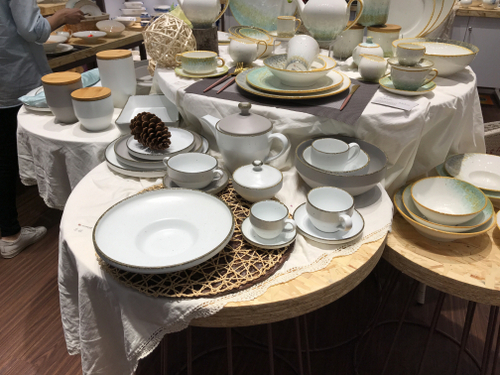Durable

Durable China - durable porcelain
A general term - unfortunately without concrete assignment
It is similarly complicated as the classification of the term "stoneware" in the German language to provide a generally valid definition of "durable". If we look at the industry leader for Durable - the porcelain factory Steelite from England - we find the term "Alumina Vitrified Tableware". In addition, there are other collections, among others from "Alpha Cream Varick". Both promise the properties of Durable, but are certainly called porcelain.
In an image brochure available to us, this manufacturer advertises the reduction of the firing temperature by 86 Fahrenheit (30 °C) as an environmentally friendly measure. Unfortunately, we do not find a clear indication of how high the firing temperature is. However, if we assume that real hard porcelain is produced at around 1,320 °C and the temperature is reduced by 30 °C, then according to the VKI definition by Friedl and Pukall, it is no longer porcelain. Granted: Steelite makes a "1a beautiful collection" and is very successful in many markets around the world. Our compliments!
If we look at some newcomers to the industry from Turkey, with very similar goods, they too speak of "porcelain", although the glaze firing is only carried out at 1,200 °C. Incidentally, we have already noticed a lack of cut resistance in the first amateur tests. According to Pukall, Friedl & VKI, this too is not porcelain!
On further journeys around the world, to India, Vietnam, Thailand, Indonesia and - of course and above all - to China, we often meet manufacturers of ceramic products who vehemently describe their goods as porcelain, even though the firing temperature is below 1,300 °C. From a technical point of view, this designation is definitely wrong!
Why does Durable Porcelain even exist?
The industry is constantly searching for new substitutes for the high-quality and expensive kaolin. Lowering the firing temperature also saves considerable costs. Whether this is due to the motivation "environmental protection" may be doubted. If a long-term environmental balance from porcelain to Durable were to be drawn up, the issue of sustainability would already be more difficult. Due to its harder glaze, hard porcelain has much less glaze corrosion and thus a longer service life.
At first glance, Durable tableware, Alumina Vitrified Tableware and many other products seem to be a real hammer for the restaurateur! Reactive glazes, brilliant decorative colours and an almost unbelievable physical resistance to mechanical impact combine modern trends, the spirit of the times and an innovative design language. Many of these manufacturers do a lot of things right.
Durable in the HoReCa industry
A lower glaze hardness reduces the cut resistance of flat parts (plates and dishes) and promotes faster glaze corrosion. However, the spirit of the times is not determined by this knowledge, but by trend, taste and unique selling propositions. Young gastronomy in particular "stands" for modern designs and colours and can be found above all in Durable Porcelain.
In long-term use, however, the importance of mechanical resistance is only second only to cut resistance and a noticeably rapidly progressing glaze corrosion. The arch enemies of Durable tableware are chemical detergents and commercial dishwashers. This insight from the Mohs definition of hardness is self-evident. One may argue whether the plate, thanks to its mechanical resistance, would have become so "old" that corrosion can occur, but the guest is then presented with a rather ugly picture - especially with white Durable crockery.
Durable - just like Vitreous China and Arcopal tempered glass tableware - is clearly justified in the catering trade! Wherever mechanical stress is greater than long-term use, break-resistant tableware can be used. Better a ceramic tableware than melamine, plastic or plastic, because that is not at all in line with the new spirit of the times! Durable is an alternative to hard porcelain and one of two arch rivals.
Durable at Holst Porzellan
By default (as of 2019/2020) we carry three insignificant articles of the "Durable" quality class in our own collection. 2 years ago we decided to carry out long-term tests and observations with this quality class. However, we will not further expand the "Durable" range. We see a much greater gastronomic benefit in the "Alumina Porcelain", "High Alumina" and "Ultra Alumina" quality classes and, of course, in the classic "Hard Porcelain" range.
These three types of alumina porcelain correspond to "real" hard porcelain due to their firing temperature and their raw material composition and additionally offer the user the mechanical stability of Durable tableware.
Note: For a better differentiation of the ceramic types, please also read our article: Quality classes of ceramics.
